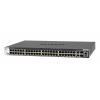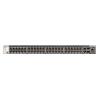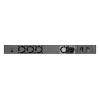-
1,22 zł netto



Netgear M4300-52G to zarządzalny switch wyposażony w 48 gigabitowych portów Ethernet, 2 porty 10G Ethernet i 2 sloty SFP+ (10 Gb/s). Urządzenie daje możliwość fizycznego stackowania, nie tylko z innymi switchami 10G, ale też 1G. Technologia NSF (non-stop forwarding) zapewnia funkcję fail-over wewnątrz jednego stosu, w przypadku awarii jednego urządzenia jego pracę powinny podjąć pozostałe. Dzięki temu uzyskano wysoką dostępność całej sieci (HA). Maksymalna ilość urządzeń na stos wynosi 8, a maksymalna ilość portów: 384x 1G lub 768x 10G lub 192x 40G.
Oferowany produkt obsługuje zaawansowane funkcje zarządzania Layer 3. Między innymi statyczny routing, RIPS, OSPF, VRRP, PIM czy PBR. W pełni wspiera filtrowanie multicast Layer2 i routing multicast Layer 3, w tym IGMP / MLD Snooping, PIM-DM, PIM-SM, również IPv6. Zarządzanie odbywa się poprzez graficzny interfejs Web lub terminali CLI, część zaawansowanych opcji dostępna jest tylko z poziomu CLI.
Switch posiada procesor o taktowaniu 800 MHz, 1 GB pamięci RAM i 256 MB pamięci wbudowanej (Flash). Prędkość przełączania wynosi 176 Gb/s, a prędkość przekazywania pakietów 130,9 Mp/s. Urządzenie zapewnia dużą wydajność i przepustowość w wielu zastosowaniach.
Najważniejsze cechy:
- 48 gigabitowych portów Ethernet 10/100/1000 Mb/s;
- 2 porty 10G Ethernet;
- 2 sloty SFP+;
- fizyczne stackowanie do 8 urządzeń;
- zarządzalnie Layer 3 (RIP, OSPF, VRRP);
- PIM-DM i PIM-SM.
Specyfikacja:
| M4300-52G | |
| Porty gigabit Ethernet i 10G Ethernet | |
|---|---|
| 10/100/1000BASE-T |
48 (10M nie jest wspierana na portach 17-24 i 41-48) |
| 100/1000/10GBASE-T | 2 |
| 100/1000/2.5/5/10GBASE-T | - |
| SFP+ 1000/10GBASE-X | 2 (niezależne) |
| QSFP+ 40GBASE-X | - |
| Porty zarządzania | |
| Konstrola |
Serial RS232 Rj45 (tył) MiniUSB (przód) |
| Out-of-band Ethernet | 1 gigabitowy port Ethenet (przód) |
| Port do podłączenia pamięci | USB (przód) |
| Procesor / pamięć | |
| Taktowanie | 800 MHz |
| Pamięć RAM | 1 GB |
| Pamięć wbudowana (flash) | 256 MB |
| Bufor pakietów | |
| Rozmiar | 16 Mb |
| Stackowanie | |
| Maksymalnie switchy na fizyczny stack | 8 |
| Maksymalnie portów na fizyczny stack | 384x 1G lub 768x 10G lub 192x 40G |
| Tryb mieszany - stackowanie 1G z modelami 10G/40G | Tak |
| Mieszany rozmiar tablicy stackowania | Mixed stacking SDM template |
| Porty do stackowania | Nie ma prekonfigurowanych portów, każdy może być użyty do stackowania |
| Maksymalna ilość portów stack | 16 na switch |
| Topologia stackowania | Chain, single ring, dual ring, mesh, spine and leaf |
| Stackowanie z użyciem światłowodu | Tak |
| NSF (non-stop forwarding) | Tak |
| Failover i failback (hitless) | Tak, bez przerw w działaniu stosu |
| AUR (Automatic unit replacement) | Tak |
| Distributed Link Aggregation (LAGs across the stack) | Tak |
| Stos z poprzednimi wersjami M5400, M7100, M7300 | Nie |
| Podsumowanie wydajności | |
| Przełączania | 176 Gb/s (non-blocking) |
| Przepustowość | 130,9 Mp/s |
| Latency (10G światłowód) |
64-byte frames: 1.24μs 512-byte frames: 1.225μs 1024-byte frames: 1.232μs 1518-byte frames: 1.196μs |
| Latency (10G Ethernet) |
64-byte frames: 2.71μs 512-byte frames: 2.7μs 1024-byte frames: 2.692μs 1518-byte frames: 2.676μs |
| Latency (1G Ethernet) |
64-byte frames: 2.688μs 512-byte frames:2.644μs 1024-byte frames: 2.648μs 1518-byte frames: 2.676μs |
| Green Ethernet |
Energy Efficient Ethernet (EEE) Compliant with IEEE 802.3az Energy Efficient Ethernet Task Force Deactivated by default |
| Pozostałe właściwości | |
| Tryb przekazywania | Store-and-forward |
| Adresacja | 48 bitowy adres MAC |
| Rozmiar tablicy | 16K |
| Maksymalna ilość VLANów |
4093 VLAN (802.1Q) jednocześnie |
| Maksymalna ilość grup multicast (IGMP) |
4K łącznie (2048 IPv4 i 2048 IPv6) |
| Maksymalna ilość LAGs |
128 grup LAG (maks. 8 portów na grupę) 802.3ad / 802.1AX-2008 |
| Maksymalna ilość kolejek QoS (samodzielnie) |
8 kolejek |
| Maksymalna ilość kolejek QoS (stack) | 7 kolejek |
| Ilość tras |
IPv4: 512 IPv4 Unicast Routes in IPv4 Routing Default SDM Template IPv6: 256 IPv6 Multicast Routes in Dual IPv4 and IPv6 SDM Template |
| Ilość statycznych tras |
IPv4: 64 IPv6: 64 |
| RIP | IPv4: 512 |
| OSPF |
IPv4: 512 IPv6: 256 |
| Ilość interfejsów IP (port lub VLAN) | 128 |
| Ramki Jumbo | Do 9KB |
| Głośność (ANSI-S10.12) | 31.5 dB przy temperaturze 25°C |
| Wydzielanie ciepła (BTU) | 161.82 BTU/hr |
| MTBF | 578,472 h (~66 godzin) |
| Właściwości oprogramowania | |
| L2 - VLANy |
IEEE 802.1Q VLAN Tagging 802.1Q-1998 Up to 4,093 VLANs - 802.1Q Tagging Protocol Based VLANs IP subnet ARP IPX Subnet based VLANs MAC based VLANs Voice VLAN Based on phones OUI bytes (internal database, or user-maintained) or protocols (SIP, H323 and SCCP) Private Edge VLAN Private VLAN IEEE 802.1x Guest VLAN RADIUS based VLAN assignment via .1x RADIUS based Filter ID assignment via .1x MAC-based .1x Unauthenticated VLAN Double VLAN Tagging Enabling dvlan-tunnel makes interface Global ethertype (TPID) Interface ethertype (TPID) Customer ID using PVID GARP with GVRP/GMRP Automatic registration for membership in VLANs or in multicast groups Multiple Registration Protocol (MRP) Multicast VLAN Registration Protocol (MVRP) MVR (Multicast VLAN registration) |
| Layer2 - dostępność |
IEEE 802.3ad - LAGs Up to 128 LAGs and up to 8 ports per group LACP LACP automatically reverts to and from Static LAG Static LAGs Local Preference per LAG LAG Hashing LAG Member Port Flaps Tracking LAG Local Preference Distributed Link Aggregation Storm Control IEEE 802.3x (Full Duplex and flow control) Per port Flow Control Priority Flow Control (PFC) Standardized by IEEE 802.1Qbb UDLD Support (Unidirectional Link Detection) Normal-Mode Aggressive-Mode Link Dependency IEEE 802.1D Spanning Tree Protocol IEEE 802.1w Rapid Spanning Tree IEEE 802.1s Multiple Spanning Tree Per VLAN STP (PVSTP) with FastUplink and FastBackbone Per VLAN Rapid STP (PVRSTP) STP Loop Guard STP Root Guard STP BPDU Guard STP BPDU Filtering STP BPDU Flooding |
| Layer2 - filtrowanie multicast |
IGMPv2 Snooping Support IGMPv3 Snooping Support NETGEAR IGMP Plus™ Enhanced Implementation MLDv1 Snooping Support MLDv2 Snooping Support Expedited Leave function Static L2 Multicast Filtering Enable IGMP / MLD Snooping per VLAN IGMPv1/v2 Snooping Querier, compatible v3 queries MLDv1 Snooping Querier IGMP Snooping Enable IGMP Snooping per VLAN Snooping Querier MGMD Snooping Control Packet Flooding Flooding to mRouter Ports Remove Flood-All-Unregistered Option Multicast VLAN registration (MVR) |
| Layer3 - routing multicast |
IGMP Proxy MLD Proxy Any Source Multicast (ASM) Source Specific Multicast (SSM) Multicast streams routing between subnets, VLANs Multicast static routes (IPv4, IPv6) DVMRP (Distance Vector Multicast Routing Protocol) Neighbor discovery PIM-DM (Multicast Routing - dense mode) PIM-DM (IPv6) PIM-SM (Multicast Routing - sparse mode) PIM-SM (IPv6) PIM multi-hop RP support PIM Timer Accuracy PIM-SM Unhandled Events IPMC replication (hardware support) |
| Layer3 - DHCP |
DHCP IPv4 / DHCP IPv6 Client DHCP IPv4 / DHCP IPv6 Server (Stateless, Stateful) DHCP Snooping IPv4 / IPv6 BootP Relay IPv4 / IPv6 DHCP Relay IPv4 / IPv6 DHCP Relay Option 82 circuit-id and remote-id for VLANs Multiple Helper IPs Auto Install (DHCP options 66, 67, 150 and 55, 125) |
| Layer3 - routing |
Static Routing / ECMP Static Routing IPv4/IPv6 Multiple next hops to a given destination Load sharing, Redundancy Default routes Static Reject routes Port Based Routing VLAN Routing 802.3ad (LAG) for router ports VRRP IPv4 Pingable VRRP interface VRRP Route/Interface Tracking Loopback Interfaces Tunnel interfaces IPv4/IPv6 Configured 6to4 tunnels Automatic 6to4 tunnels RIP IPv4 RIPv1/RIPv2 Route Redistribution OSPF IPv4/IPv6 OSPFv2 RFC 2328 including older RFC 1583 support OSPFv3 OSPF Not-So-Stubby Area (NSSA) Option Forwarding of OSPF Opaque LSAs Passive interface feature Static Area Range Costs feature OSPF Equal Cost Multipath (ECMP) Dynamically learned ECMP routes Statically learned ECMP routes OSPF Max Metric feature Automatic Exiting of Stub Router Mode feature Static Area Range Costs feature OSPF LCA Pacing feature OSPF Flood Blocking feature OSPF Transit-Only Network Hiding IP Multinetting ICMP throttling Router Discovery Protocol DNS Client IPv4/IPv6 IP Helper Max IP Helper entries 512 IP Event Dampening IPv4/IPv6 Proxy ARP IPv4/IPv6 ICMP IPv4/IPv6 ICMP redirect detection in hardware Policy Based Routing (PBR) Based on the size of the packet IPv4/IPv6 Based on the Protocol of the payload (Protocol ID field) Based on Source MAC address Based on Source or Destination IP address Based on VLAN tag Based on Priority(802.1P priority) |
| Monitorowanie sieci i narzędzie discovery |
ISDP (Industry Standard Discovery Protocol) 802.1ab LLDP 802.1ab LLDP - MED SNMP V1, V2, V3 RMON 1,2,3,9 sFlow (IPv4 and IPv6 headers) |
| Network Storm Protection, DoS |
Broadcast, Unicast, Multicast DoS Protection Denial of Service Protection (control plane) Switch CPU protection Denial of Service Protection (data plane) Switch Traffic protection DoS Attacks Protection
CPU Rate Limiting - Applied to IPv4 and IPv6 multicast packets with unknown L3 addresses when IP routing/multicast enabled ICMP throttling - Restrict ICMP, PING traffic for ICMP-based DoS attacks |
| Zarządzanie |
Management ACL (MACAL) Max Rules - 64 Out of band Management Radius accounting - RFC 2565 and RFC 2866 TACACS+ Malicious Code Detection - Software image files and Configuration files with digital signatures |
| Ruch sieciowy |
Access Control Lists (ACLs) L2 / L3 / L4 MAC, IPv4, IPv6, TCP, UDP Time-based ACLs Protocol-based ACLs ACL over VLANs Dynamic ACLs IEEE 802.1x Radius Port Access Authentication - Up to 48 clients (802.1x) per port are sup-ported, including the authentication of the users domain 802.1x MAC Address Authentication Bypass (MAB) - Supplemental authentication mechanism for non-802.1x devices, based on their MAC address only Network Authentication Successive Tiering - Dot1x-> MAP -> Captive Portal successive authentication methods based on config-ured time-outs Port Security IP Source Guard IPv4 / IPv6 DHCP Snooping IPv4 / IPv6 Dynamic ARP Inspection IPv4 / IPv6 IPv6 RA Guard Stateless Mode MAC Filtering Port MAC Locking Private Edge VLAN - A protected port doesn’t forward any traffic (unicast, multicast, or broadcast) to any other protected port - same switch Private VLANs - Scales Private Edge VLANs by providing Layer 2 isolation between ports across switches in same Layer 2 network |
| Funkcja QoS (Quality of Service) - podsumowanie |
Access Lists L2 MAC, L3 IP and L4 Port ACLs Ingress Egress 802.3ad (LAG) for ACL assignment Binding ACLs to VLANs ACL Logging Support for IPv6 fields DiffServ QoS Edge Node applicability Interior Node applicability 802.3ad (LAG) for service interface Support for IPv6 fields Ingress/Egress IEEE 802.1p COS 802.3ad (LAG) for COS configuration WRED (Weighted Deficit Round Robin) Strict Priority queue technology Single Rate Policing Committed Information Rate Committed Burst Size Excessive Burst Size DiffServ feature applied to class maps Auto-VoIP - Yes, based on protocols (SIP, H323 and SCCP) or on OUI bytes (default database and user-based OUIs) in the phone source MAC address iSCSI Flow Acceleration Dot1p Marking IP DSCP Marking |
| QoS - funkcje ACL |
ACL Support (general, includes IP ACLs) MAC ACL Support IP Rule Match Fields: Destination IP Inbound/Outbound Destination IPv6 IP Inbound/Outbound Destination L4 Port Inbound/Outbound Every Packet Inbound/Outbound IP DSCP Inbound/Outbound IP Precedence Inbound/Outbound IP TOS Inbound/Outbound Protocol Inbound/Outbound Source IP (for Mask support see below) Inbound/Outbound Source IPv6 IP Inbound/Outbound L3 IPv6 Flow Label Inbound Source L4 Port Inbound/Outbound TCP Flag Inbound/Outbound Supports Masking Inbound/Outbound MAC Rule Match Fields COS Inbound/Outbound Destination MAC Inbound/Outbound Destination MAC Mask Inbound/Outbound Ethertype Inbound/Outbound Source MAC Inbound/Outbound Source MAC Mask Inbound/Outbound VLAN ID Inbound/Outbound Rules attributes Assign Queue Inbound Logging -- deny rules Inbound/Outbound Mirror (to supported interface types only) Inbound Redirect (to supported interface types only) Inbound Rate Limiting -- permit rules Inbound/Outbound Interface Inbound direction Outbound direction Supports LAG interfaces Supports Control-plane interface Multiple ACLs per interface, dir Mixed-type ACLs per interface, dir Mixed L2/IPv4 ACLs per interface, inbound Mixed IPv4/IPv6 ACLs per interface, inbound Mixed IPv4/IPv6 ACLs per interface, outbound |
| QoS - funkcje DiffServ |
DiffServ Supported Class Type All Class Match Criteria COS Inbound/Outbound COS2 (Secondary COS) Inbound Destination IP (for Mask support see below) Inbound/Outbound Destination IPv6 IP Inbound/Outbound Destination L4 Port Inbound/Outbound Destination MAC (for Mask support see below) Inbound/Outbound Ethertype Inbound/Outbound Every Packet Inbound/Outbound IP DSCP Inbound/Outbound IP Precedence Inbound/Outbound IP TOS (for Mask support see below) Inbound/Outbound Protocol Inbound/Outbound Reference Class Inbound/Outbound Source IP (for Mask support see below) Inbound/Outbound Source IPv6 IP Inbound/Outbound L3 IPv6 Flow Label Inbound Source L4 Port Inbound/Outbound Source MAC (for Mask support see below) Inbound/Outbound VLAN ID (Source VID) Inbound/Outbound VLAN ID2 (Secondary VLAN) (Source VID) Inbound/Outbound Supports Masking Inbound/Outbound Policy Out Class Unrestricted Policy Attributes -- Inbound Assign Queue Drop Mark COS Mark COS-AS-COS2 Mark COS2 (Secondary COS) Mark IP DSCP Mark IP Precedence Mirror (to supported interface types only) Police Simple Police Single-Rate Police Two-Rate Police Color Aware Mode Redirect (to supported interface types only) Policy Attributes -- Outbound Drop Mark COS Mark IP DSCP Mark IP Precedence Mirror (to supported interface types only) Police Simple Police Single-Rate Police Two-Rate Police Color Aware Mode Redirect (to supported interface types only) Service Interface Inbound Slot.Port configurable Inbound 'All' Ports configurable Outbound Slot.Port configurable Outbound 'All' Ports configurable Supports LAG interfaces Mixed L2/IPv4 match criteria, inbound Mixed IPv4/IPv6 match criteria, inbound Mixed IPv4/IPv6 match criteria, outbound PHB Support EF AF4x AF3x AF2x AF1x CS Statistics -- Policy Instance Offered packets Discarded packets |
| QoS - funkcje COS |
COS Support Supports LAG interfaces COS Mapping Config Configurable per-interface IP DSCP Mapping COS Queue Config Queue Parms configurable per-interface Drop Parms configurable per-interface Interface Traffic Shaping (for whole egress interface) Minimum Bandwidth Weighted Deficit Round Robin (WDRR) Support Maximum Queue Weight - 127 WRED Support |
| PTP - PTPv2 |
PTPv2 IEEE 1588 PTPv2 Section 10 and 11.5 Implementation - Transparent Clock (TC) End-to-End implementation considering the residence time of PTPv2 packets from ingress to egress Limitations - Standalone mode, or Stack Master only. On M4300-52G and M4300-52G-PoE+ models, PTPv2 is supported between port 1 and port 24, and between port 25 and port 48. PTPv1 packets are forwarded but not processed (no PTPv1 support). Method - Residence time of the PPTPv2 packet at the egress port level PTPv2 packet fields that are updated - The "Sync & Delay_Req" field of passing/egressing out PTPv2 packets is updated with the residence time in the switch PTPv2 packet fields that are NOT updated - Other fields in PTPv2 packets ("Announce", "Delay_Resp", "Pdelay_Req" and "Pdelay_Resp") are not updated |
| Zarządzanie |
Password management Configurable Management VLAN Out-of-band Management - In-band management can be shut down using Management ACLs when separate management network Auto Install (BOOTP and DHCP options 66, 67, 150 and 55, 125) - Scalable deployment process (firmware, config) Admin access control via Radius and TACACS+ - Policies, Enable Industry standard CLI (IS-CLI) - Command Line interface CLI commands logged to a Syslog server Web-based graphical user interface (GUI) - Fully functional GUI (exceptions are noted below:) Features without Web GUI support PFC (Priority Flow Control) PV(R)STP Authorization List Control Plane ACL UDLD Policy Based Routing LLPF QoS Policy for Single Rate DHCPv6 Snooping IPv6 DHCP Relay eMail Alerting MMRP Telnet IPv6 management Dual Software (firmware) image - Allows non disruptive firmware upgrade process Editable Configuration file - Text-based (CLI commands) configuration file Non disruptive Config Management - With new startup configuration file, the switch gracefully resolves any differences with the running config IS-CLI Scripting Port descriptions SNTP client over UDP port 123 - Provides synchronized network timestamp either in broadcast or unicast mode XMODEM SNMP v1/v2 SNMP v3 with multiple IP addresses RMON 1,2,3,9 Max History entries 3 * (number of ports in the chassis + LAG + 10) Max buckets per History entry - 10 Max Alarm entries 3 * (number of ports in the chassis + LAG + 10) Max Event entries 3 * (number of ports in the chassis + LAG + 10) Max Log entries per Event entry - 10 Port Mirroring Number of monitor sessions - 1 (multiple sessions are configurable) Tx/Rx Many to One Port Mirroring LAG supported as source ports Max source ports in a session - Total switch port count Remote Port Mirroring (RSPAN) - When a particular session is enabled, any traffic entering or leaving the source ports of that session is copied (mirrored) onto a Remote Switched Port Analyzer (RSPAN) VLAN Flow based mirroring Cable Test utility - CLI, Web GUI Outbound Telnet SSHv2 - Secure Shell version 2 (OpenSSH 7.5p1) SSH Session Configuration SSL v3 and TLS v1.2 for HTTPS web-based access - (Open SSL 1.0.2o) 2048-bit RSA key pairs - For SSLv3 and SSHv2 SHA2-256 and SHA2-512 cryptographic hash functions - For SSLv3 and SSHv2 File transfers (uploads, downloads) - TFTP / HTTP Secured protocols for file transfers - SCP / SFTP / HTTPS HTTP Max Sessions - 16 SSL/HTTPS Max Sessions - 16 HTTP Download (firmware) Email Alerting Syslog (RFC 3164) (RFC 5424) - forwarding messages via UDP using the Syslog protocol to one or more collectors or relays Persistent log supported |
| Zarządzanie użytkownikami |
User ID configuration Max number of configured users - 6 Support multiple READWRITE Users Max number of IAS users (internal user database) - 100 Authentication login lists Authentication Enable lists Authentication HTTP lists Authentication HTTPS lists Authentication Dot1x lists Accounting Exec lists Accounting Commands lists Login History - 50 |
| Stałe wartości plaftormy |
Maximum number of remote Telnet connections - 5 Maximum number of remote SSH connections - 5 Number of MAC Addresses - 16K Number of VLANs - 4,093 VLANs (802.1Q) simultaneously - standalone mode - 4,093 VLANs - stack mode VLAN ID Range 1- 4093 Number of 802.1p Traffic Classes - 8 classes (standalone) - 7 classes (stack) IEEE 802.1x Number of .1x clients per port - 48 Number of LAGs - 128 LAGs with up to 8 ports per group Maximum multiple spanning tree instances (MSTP) - 32 Maximum per VLAN spanning tree instances (PVST) - 32 MAC based VLANS Number supported - 256 Number of network buffers - 246 Number of log messages buffered - 200 Static filter entries Unicast MAC and source port - 20 Multicast MAC and source port - 20 Multicast MAC and destination port (only) - 2048 Subnet based VLANs Number supported - 128 Protocol Based VLANs Max number of groups - 128 Max protocols - 16 Maximum Multicast MAC Addresses entries - 2K Jumbo Frame Support Max Size Supported - 9k Number of IP Source Guard stations - 379 Number of DHCP snooping bindings - 32K Number of DHCPv6 snooping bindings - 32K Number of DHCP snooping static entries - 1024 LLDP-MED number of remote nodes - 2 x Total stack port count LLDP Remote Management address buffers - 2 x Total stack port count LLDP Unknown TLV address buffers - 100 LLDP Organisationally Defined Large TLV buffers - Total stack port count LLDP Organisationally Defined Small TLV buffers - 12 x Total stack port count Port MAC Locking Dynamic addresses per port - 4096 Static addresses per port - 48 sFlow Number of samplers - Total stack port count Number of pollers - Total stack port count Number of receivers - 8 Radius Max Authentication servers - 32 Max Accounting servers - 32 Number of Routes (v4/v6) IPv4 only SDM build - 512 IPv4/IPv6 SDM build IPv4 routes - 512 IPv6 routes - 256 RIP application route scaling - 512 OSPF application route scaling - 12K Number of routing interfaces (including port/vlan) - 128 Number of static routes (v4/v6) - 64/64 OSPF OSPFv2 max neighbors - 400 OSPFv3 max neighbors - 400 OSPFv3 max neighbors per interface - 100 Tunnels Number of configured v6-over-v4 tunnels - 8 Number of automatic (6to4) tunnels - 1 Number of 6to4 next hops - 16 DHCP Server Max number of pools - 256 Total max leases - 2K DNS Client Concurrent requests - 16 Name server entries - 8 Seach list entries - 6 Static host entries - 64 Cache entries - 128 Domain search list entries - 32 DHCPv6 Server Max number of pools - 16 DNS domain names within a pool - 5 DNS server addresses within a pool - 8 Delegated prefix definitions within a pool - 10 Number of Host Entries (ARP/NDP) IPv4 only SDM build - 888 IPv4/IPv6 SDM build (v4/v6) - 128 Static v4 ARP Entries - 128 Number of ECMP Next Hops per Route - 4 Number of ECMP groups - 128 Total ECMP nexthops in Hardware - 2048 Maximum MFDB entries Native SDM template - 1K SDM Mixed Stacking mode template - 1K IGMPv3 / MLDv2 Snooping Limits IGMPv3/MLDv2 HW entries when IP Multicast present - 64/32 IP Multicast Number of IPv4/IPv6 Multicast Forwarding Entries - 96/2 IGMP Group Memberships per system - 2K (IPv4) and 2K (IPv6) IPv4 Multicast routes (IPv4 only) - 128 DVMRP Neighbors - 256 PIM-DM Neighbors - 256 PIM-SM Neighbors - 256 PIM-SM Static RP Entries - 5 PIM-SM Candidate RP Group Range Entries - 20 PIM-SM SSM Range Entries - 5 IGMP Sources processed per group per message - 73 ACL Limits Maximum Number of ACLs (any type) - 100 Maximum Number Configurable Rules per List - 1,023 ingress / 511 ingress Maximum ACL Rules per Interface and Direction - 1,023 ingress / 511 ingress Maximum ACL Rules per Interface and Direction (IPv6) - 893 ingress / 509 egress Maximum ACL Rules (system-wide) - 16K Maximum ACL Logging Rules (system-wide) - 128 COS Device Characteristics Configurable Queues per Port - 8 queues (standalone) 7 queues (stack) Configurable Drop Precedence Levels - 3 DiffServ Device Limits Number of Queues - 8 queues (standalone) 7 queues (stack) Requires TLV to contain all policy instances combined Max Rules per Class - 13 Max Instances per Policy - 28 Max Attributes per Instance - 3 Max Service Interfaces - 116 Max Table Entries Class Table - 32 Class Rule Table - 416 Policy Table - 64 Policy Instance Table - 1,792 Policy Attribute Table - 5,376 Max Nested Class Chain Rule Count - 26 AutoVoIP number of voice calls - 20 iSCSI Flow Acceleration Max Monitored TCP Ports/IP Addresses - 16 Max Sessions - 192 Max Connections - 192 |
| Właściwości fizyczne / środowiskowe / zasilania | |
| Diody LED |
Na port: Speed / Link / Activity
Na urządzenie: Power 1, Power 2, Fan, Stack Master, Stack ID |
| Wymiary |
Szerokość: 44 cm Wysokość: 1U - 4,4 cm Głębokość: 31 cm |
| Waga | 4,91 kg |
| Maksymalny pobór mocy | 47,7 W |
| Dopuszczalna temperatura pracy | Od 0 do 50 st. C |
| Dopuszczalna wigltoność powietrza | Do 90% RH niekondensująca |
| Dopuszczalna temperatura przechowywania | Od -20 do 70 st. C |
| Dopuszczalna wilgotność powietrza podczas przechowywania | Do 95% RH niekondensująca |






 Polski
Polski English
English Italiano
Italiano Español
Español Čeština
Čeština Српски
Српски Deutsch
Deutsch Ελληνικά
Ελληνικά Slovenský
Slovenský




